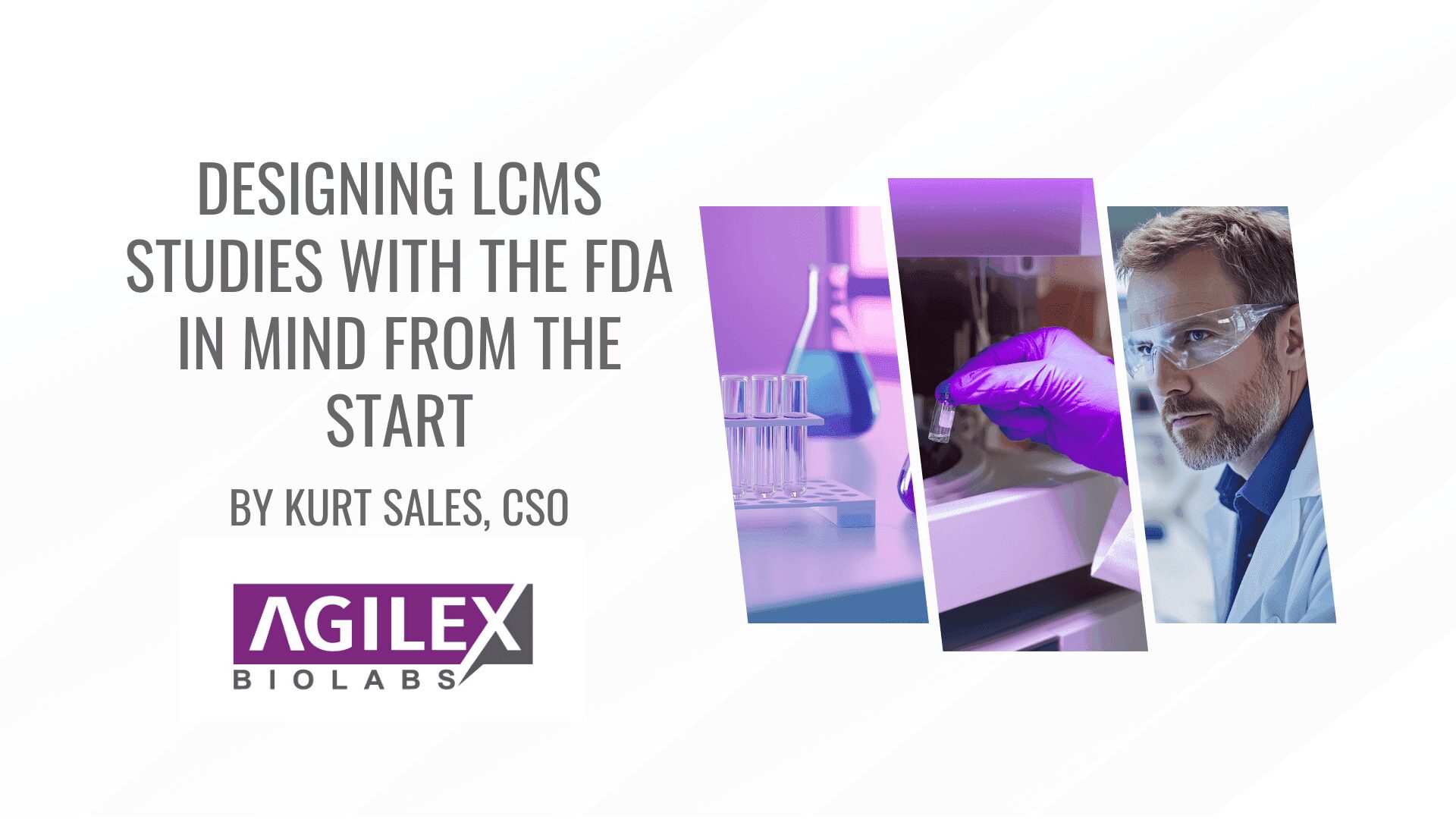By Dr. Kurt Sales, CSO
Liquid chromatography-mass spectrometry (LCMS) has become an indispensable tool for the pharmaceutical and biotechnology industries. It is powerful, precise, and capable of generating complex datasets that are instrumental in drug development. However, navigating LCMS studies effectively involves more than just technical expertise – it requires anticipating regulatory needs, especially from the U.S. Food and Drug Administration (FDA), right from the onset.
By aligning your study design with FDA expectations from the start, you can streamline the path from method development to final regulatory approval. Here, we cover some of the best practices for LCMS method development and validation employed at Agilex Biolabs, along with common pitfalls to avoid – helping you not only speed up your timeline but also maximize the quality of your outcomes.
Start with the End in Mind: Regulatory Requirements as Your Compass
Designing an LCMS study with the FDA in mind means that you’re not just aiming to prove your method is scientifically sound and robust – you’re also demonstrating that it complies with the stringent regulatory requirements set forth by the FDA and other regulatory agencies. The best way to achieve this is to think of your final submission as the target and work backward from there. To meet these standards, consider the following core regulatory areas for your assay: accuracy, precision, selectivity, sensitivity, linearity, and robustness.
From the very beginning, understand how your LCMS method needs to fit into the regulatory landscape – whether it’s for bioanalysis in support of a clinical trial or a drug approval application. Each intended use has specific requirements and guidance documents that can serve as a roadmap for your study design. For example, ICH M10 Bioanalytical Method Validation and Study Sample Analysis Guidance, adopted by regulatory agencies, including the FDA, as part of global harmonization of Bioanalytical Method Validation, provides detailed directions for acceptable validation parameters, including calibration curve performance, quality control standards, and reproducibility.
Best Practices for LCMS Method Development and Validation
1. Defining the Assay
Defining the assay limits, criteria and purpose are an essential starting point when considering an LCMS assay for your first in human study, to ensure that your method produces data that is both accurate and reproducible, enabling you to make informed decisions during dose escalation.
At Agilex, early engagement in the run up to a clinical trial is crucial to establish the assay requirements and parameters early: What analytes are you measuring, and in what matrix (e.g., plasma, urine, tissue)? Are you targeting only the primary active pharmaceutical ingredient (API) or known drug metabolites as well? What sensitivity and assay range is required in order to meet the needs of a dose escalation study? Answering these questions will help your Bioanalytical lab determine the level of sensitivity and selectivity required for your method and determine the analytical range. As part of the assay setup at Agilex, we also look into sample collection conditions. This is crucial as collecting a non-viable sample or using an incorrect collection tube/vessel in the clinic will significantly impact the quality of the data. Many small molecule compounds are sticky – adhering to certain plastics, meaning that we could be under reporting the concentration in the sample if the collection conditions are not optimized.
2. Prioritize Selectivity and Robustness
One of the key aspects the FDA will scrutinize is selectivity—the ability of your method to distinguish the analyte from other components. Selectivity can be impacted by matrix effects, which occur when endogenous substances interfere with analyte measurement. This is where reliable sample preparation plays a critical role. Techniques such as protein precipitation, solid-phase extraction (SPE), or liquid-liquid extraction can help you achieve better selectivity. At Agilex, our Scientists have decades’ experience in being able to optimize the extraction procedure to ensure selectivity, based on the physicochemical nature of the drug.
Robustness is another critical aspect, ensuring that your method yields consistent results under variable conditions. When designing an LCMS study, Agilex Scientists will optimize all chromatographic conditions including pH, mobile phase composition, and flow rate to ensure that the method is robust and returns reproducible data, helping to satisfy the FDA’s need for reproducible and reliable data.
3. Calibration and Quality Control Standards
Calibration curves are foundational to demonstrating linearity. Calibration standards are prepared by spiking matrix with known quantities of analyte, span the calibration range and comprise the calibration curve. The curve must be both accurate and reproducible over your intended range of concentrations. Often, the use of at least six to eight concentration points, including the LLOQ and ULOQ is ideal to demonstrate linearity. The use of stable isotopically labeled internal standards (SIL-IS) are an essential component of a robust assay as they help compensate for matrix effects and signal variability, ensuring the accuracy of your quantification.
Additionally, implementing stringent Quality Control (QC) samples at low, medium, and high levels throughout your runs can confirm the precision and accuracy of your method. QC samples are intended to mimic study samples and are prepared by spiking matrix with known concentrations of the analyte and then storing them under the same conditions anticipated for study samples during the clinical trial. The FDA typically expects the accuracy of each concentration level to be within 15% of the nominal concentration, except the LLOQ where it should be within 20%.
4. Matrix Considerations
FDA reviewers pay close attention to the validation of matrix effects, as these can impact quantitation accuracy. Therefore, part of your method validation should include evaluating different lots of biological matrices to assess potential interference. At Agilex, our Scientists pay close attention to matrix effects, especially for patient populations or studies in rare matrices.
5. Stability Testing
Demonstrating the stability of both your analyte and your analytical method is critical. During method validation, analyte stability is tested under various conditions, including benchtop, freeze-thaw, and long-term storage. This evaluates what happens to the sample when stored under specific conditions eg: at the clinical trial site. Stability testing can often be overlooked, but failing to include it will almost certainly lead to delays during FDA review. At Agilex, our Scientists will start stability testing as early as during the method development phase to gain an understanding of the how the molecule behaves in solution. Formal stability testing for long term stability will be setup at the start of the validation to ensure that by the time we receive those first samples from the clinic, we have proven stability for common storage conditions (nominal minus 20C or minus 80C). This is essential when considering batch analysis as you want to ensure that samples are consistently analyzed within stability.
Pitfalls to Avoid in LCMS Studies
While best practices are essential to follow, understanding common pitfalls can be equally informative. Here are some of the main traps that can hinder your LCMS study:
1. Ignoring the FDA’s Guidance Documents
The FDA has released numerous guidance documents that outline expectations for method development, validation, and bioanalytical procedures – most recent being the ICH M10 Bioanalytical Method Validation and Study Sample Analysis Guidance for Industry (November 2022). Whilst these are nonbinding recommendations, a common pitfall is neglecting to thoroughly study and apply these guidelines to method development and validation, leading to gaps in method validation that the FDA will flag. At Agilex, all LCMS methods are developed and validated according to the M10 guidance in order to ensure the assay is set up to meet the requirements of the phase of the study, fit for purpose, and meet the requirements of the study protocol, ensuring that all data is generated fit for the intended purpose of the study.
2. Inadequate Sample Preparation
Sample preparation is a critical step that should not be underestimated. Many small molecule drugs suffer from non-specific binding and inadequate sample preparation can lead to under-recovery or significant matrix effects and irreproducible results. At Agilex, sample processing is evaluated first and foremost during the method development phase to ensure that collection conditions in the laboratory manual are well described and any additives that are required to stabilize the sample are added during collection. In addition, it is crucial to optimize sample preparation techniques—whether it be liquid-liquid extraction, SPE, or another approach—early in the method development process to ensure a robust assay outcome.
3. Skipping Method Reproducibility
The objective of the validation is to prove that the LCMS method is reproducible – across different analysts, different days, and different instruments (if applicable). Many studies overlook full validation, opting instead for a narrower approach that focuses on limited testing. Unless the method is being setup as an exploratory fit-for-purpose or qualified assay, this will not meet FDA standards and can delay approvals and significant justification would need to be made as to why the M10 guidance has not been adhered to for the specific assay.
4. Not Planning for Contingencies
Complex LCMS methods often require iterative optimization during method development to ensure that we produce an assay that is fit for purpose. A common pitfall is to underestimate the time needed for method development. Regulatory-compliant methods are built through continuous improvement during the R&D phase as the Scientists step through the M10 Guidance in the lab, and it is crucial to allow time for method tweaks, troubleshooting, and system suitability testing. Planning ahead for your clinical study and engaging your Bioanalytical provider as early on as possible (even as early as during the GLP Tox phase once you have a working method and some performance and stability data) can derisk your study and keep your project on track.
5. Underestimating Documentation Needs
The FDA places heavy emphasis on data integrity. Poor documentation – or worse, gaps in documentation – can easily trigger inspection findings and negatively impact the review process. It is thus imperative that you select a reputable Bioanalytical provider with a quality reputation and strong quality assurance team. Agilex Biolabs is an FDA-inspected Bioanalytical laboratory, with a reputation for quality. From instrument maintenance logs to method development rationale, method validation documentation and study conduct, documenting every part of your LCMS journey is crucial.
Final Thoughts: Bringing It All Together for FDA Success
Designing LCMS studies with the FDA, or other regulatory agencies in mind involves thinking beyond just generating data; it’s about ensuring that your methods and your outcomes are rock-solid from a regulatory standpoint. By following best practices – from defining the assay at the outset to meticulous calibration and validation – you’ll create an LCMS study that not only passes scientific scrutiny but also regulatory review. Avoiding common pitfalls will help to maintain timelines and facilitate smoother FDA interactions, bringing your product to market faster.
If you’re embarking on an LCMS study and are seeking guidance on how to make it FDA-ready, the Agilex team are here to help. We specialize in navigating the complexities of regulatory-compliant study design and would be happy to partner with you on your journey. Feel free to reach out via our website or drop us an email at BD@AGILEXBIOLABS.COM to start the conversation. Let us make your next LCMS project a success from the very beginning.


